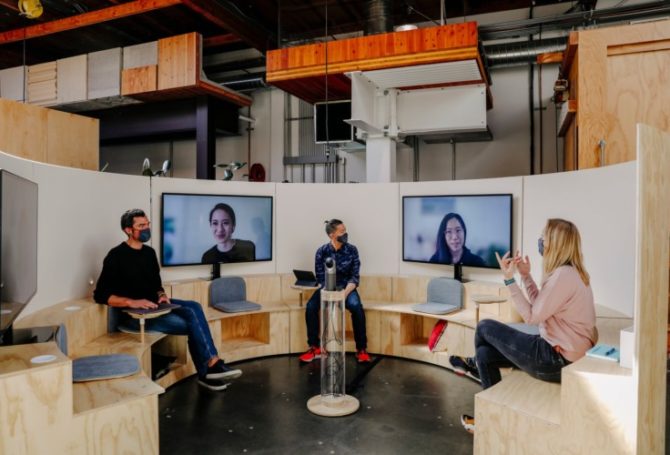
The COVID-19 pandemic inarguably changed the world of work, but it most likely hasn’t signed the death warrant of working in an office. Google is hard at work trying to define how the post-pandemic office looks, feels and functions. Its example should be followed by all business owners who want to see office work again.
The New York Times published a feature story about Google’s experimentation that highlighted some of the gadgets it is testing such as outdoor tents, balloon walls and privacy robots, gizmos that are unlikely to become office staples elsewhere. More telling are the principles of office reinvention that Google is employing.
“Google focused on three trends,” according to The Times. “Work happens anywhere and not just in the office; what employees need from a workplace is changing constantly; and workplaces need to be more than desks, meeting rooms and amenities.” What futurists foresaw for offices 10 years from now is suddenly in play now.
A fundamental change is organizing office space into what Google calls “team pods”. Each pod is allotted chairs, desks, whiteboards and storage units on casters that can be moved around by team members and rearranged almost at will.
Meeting rooms are called “campfires” because they are situated in a semicircle that enables face-to-face sessions with social distancing. The setup also permits displays in between live meeting participants to accommodate remote workers or team members from other work sites. The wood campfire structure is portable and can be moved around in an office or shipped virtually anywhere.
Outdoor tents offer alternative work environments with the features of an indoor office, such as flooring, electricity and WiFi, plus grass and a breeze. Clusters of Adirondack chairs provide a pleasant alternative to conference rooms. Google says it will build outdoor office space in its main office in Silicon Valley, Los Angeles and Sydney, as well as in more challenging year-round environments in London, Munich and New York.
Office desks can be shared by multiple employees, who reserve them on specific days. Google is exploring ways to make walls moveable and ventilation personal with a flexible fabric overhead air duct system. The tech giant also is developing a way for employees to swipe their ID badge to calibrate a computer display to a worker’s preferred tilt, move the desk to a sitting or standing position, adjust work station lighting and even display family photos. Individual preferences would extend to the temperature at a work station, eliminating a constant workplace battle over whether space is too hot or too cold.
The privacy robots and balloon walls come into play when a worker requires quiet or a period of isolation to concentrate on a project. This isn’t practical for lots of offices, but the concept of reserving quiet spots makes a lot of sense. Those now unused conference rooms could easily be converted to private work space, which is how they often were used before the pandemic.
Google focused on three trends: Work happens anywhere and not just in the office; what employees need from a workplace is changing constantly; and workplaces need to be more than desks, meeting rooms and amenities.
For Google, which has provided lots of incentives for employees to go to the office and stay at the office to work, the pandemic has created new aspirations by workers who don’t want to eat three meals and work out at the office every day. Realizing productivity hasn’t suffered because of remote work, the company is searching for ways to entice hybrid work patterns, with some in-office presence. With 140,000 employees in 170 cities and 60 countries, that will be a challenge. For smaller, more localized companies, meeting the challenge of hybrid work might be easier.
Just as municipal planners are adjusting their thinking in light of explosive growth in e-commerce, business owners and owners of downtown skyscrapers should be focusing on the future of offices. Google’s experimentation offers insights. But it’s likely each business and skyscraper may have to search for its own office and space use future. To attract even occasional worker visits to the office may require more than space flexibility and personalization. It may require next-generation perks from Google’s three meals and free workouts approach.
One way to scheme a return to the office is countering the discomforts and inconveniences of working from home, such as interruptions by a child or pet, cramped work space or inconsistent internet connections. Many employees would be glad just to see fellow workers in person again.
Ideas could include team in-office days, group learning experiences, comfortable work stations, updated technology, hyper-sanitary environments and access to services such as mental health counseling. Employers could incent hybrid work patterns by providing work-life balance incentives, creating cross-functional teams and encouraging collaborative work by in-office and online participants.
More fundamentally, business owners and managers need to develop and sell credible reasons to come to the office for work. Owners and managers should be careful not to reward employees for showing up at the office over those who choose to continue to work remotely. There can be recognition for both sets of workers.
Office space owners and managers can’t be complacent that everything will return to normal. They should be on the forefront of thinking about fresh ways to lease and “build out” space. That could include offering the most advanced amenities such as the capability for individualized ventilation, highly flexible space and access to 5G WiFi. They might even explore privacy robots and balloon walls.




